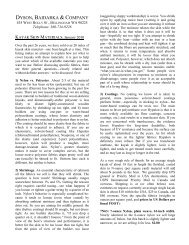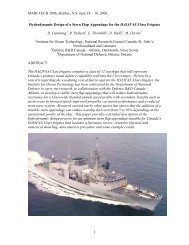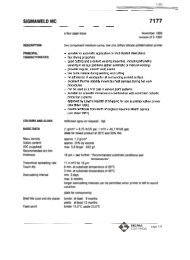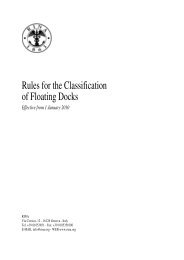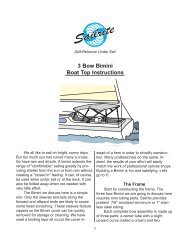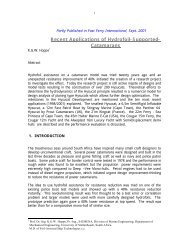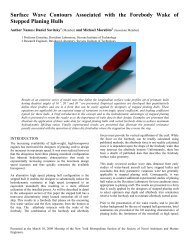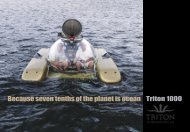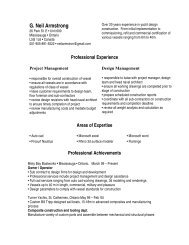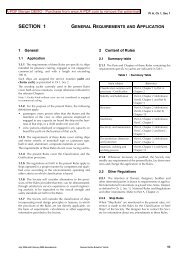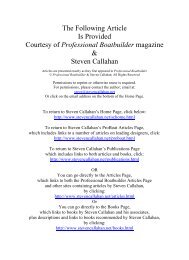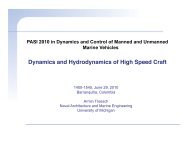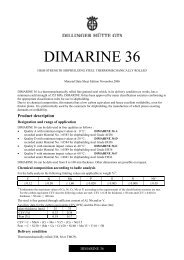Amended July 2011, see page 3 Rules for High Speed, Light Craft and Naval Surface Craft, January 2011Pt.3 Ch.3 Sec.2 – Page 17C. Corrosion ProtectionC 100 General101 Loss of structural strength due to corrosion is not acceptable.102 All surfaces that are not recognised as inherently resistant to the actual marine environment are to beadequately protected against corrosion.Guidance note:In these rules, corrosion is defined as degradation of material due to environmental influence.---e-n-d---of---G-u-i-d-a-n-c-e---n-o-t-e---C 200 For information and approval201 Specifications for corrosion protection, i.e. for coating, if applied, see 301, and for cathodic protection(including calculations), see 403, are to be submitted for information. The specifications are basis for approvalof drawings of the cathodic protection system.202 Drawings of cathodic protection system, e.g. fastening, numbers and distribution of anodes and referenceelectrodes (if impressed current), are subject to approval.203 Selection and combination of materials for exposure to sea water and/or marine atmosphere are subjectto approval.C 300 Coating301 If coating is applied, the specification is to be submitted for information.Guidance note:Coating of aluminium hulls is normally not required (see B200). However, hulls normally need to be coated for antifoulingpurposes. When coating is applied, it will influence the corrosion resistance of the hull, and constitute a basisfor cathodic protection design. The coating system including surface preparation before coating should therefore besubmitted for information.The following is normally included in a specification for coating:— metal surface cleaning and preparation before application of the primer coat, including treatment of edges andwelds— build-up and application of coating system with individual coats— curing times and over-coating intervals— acceptable temperatures of air and metal surface and dryness or humidity conditions during the above mentionedoperations (normally, the metal surface is minimum 3 °C above the dew point and the relative humidity is below85%)— thickness of individual coats and final coating system— resistance to cathodic disbonding (for coatings to be used in connection with impressed current).---e-n-d---of---G-u-i-d-a-n-c-e---n-o-t-e---302 A sound anti-corrosion coating should always be combined with the anti-fouling coating on the externalhull.303 Anti-corrosion coating is not to contain copper or other constituents that may cause galvanic corrosionon the aluminium hull.304 Hull integrated water ballast tanks and other tanks holding corrosive liquids are to be coated. Allstiffeners and frames in these tanks are to be welded to plating with double continuous welding, see Sec.8 B202.305 In other internal compartments of the hull where corrosive water is likely to occur, the lower 0.5 m ofthe internal bottom surface, measured along the plate on each side of the keel, and the corresponding sectionof the bulkheads, is normally to be coated. The preparation of surfaces including welds and edges shall be suchthat the coating can be properly applied.Guidance note:The use of 6000 alloys containing more than 0.15% Cu in internal compartments without coating may be restricted.Stagnant, chloride-containing water in internal compartments, e.g. condensation water, may cause corrosion onaluminium alloy plates and structures. Corrosion attacks will usually be of localised type, e.g. in the form of pitting.Corrosion attacks of galvanic type may also occur, see also 500, e.g. if equipment made of other metal alloy remainsin electrical contact with aluminium alloy material.Corrosion attacks of the above mentioned types can be reduced by means of e.g.:— coating applied as described above— regular cleaning, drying and inspection of the actual compartment— electrical isolation of any other metallic part from aluminium alloy plates and structures— use of dehumidifying equipment in a closed compartment<strong>DET</strong> <strong>NORSKE</strong> <strong>VERITAS</strong> AS
Rules for High Speed, Light Craft and Naval Surface Craft, January 2011 Amended July 2011, see page 3Pt.3 Ch.3 Sec.2 – Page 18— ventilation holes (minimum 2)— drainage holes— hot air fans.---e-n-d---of---G-u-i-d-a-n-c-e---n-o-t-e---C 400 Cathodic protection401 Cathodic protection of aluminium hulls can be obtained with aluminium or zinc sacrificial anodes orimpressed current. Magnesium based sacrificial anodes are not to be used, and impressed current is not to beused in internal hull compartments.402 Cathodic protection is normally to be applied to aluminium hull craft due to electrical connection of thealuminium with another metals (in propeller, water jet, etc.), which may initiate galvanic corrosion, and toprotect the hull against local corrosion and damage that normally will occur in protective coatings.403 The following is normally to be included in a cathodic protection specification:— areas to be protected (m 2 ) for hull and attached metallic components such as water jet unit and water jet duct— stipulated protective current density demand (mA/m 2 ) for coated and not coated surfaces of hull andattached components, respectively— total current demand (A)— target design life of cathodic protection system— anode material and manufacturer— for sacrificial anodes; calculation of anode mass, distribution, total number— for impressed current systems; current capacity of rectifiers and anodes— for impressed current systems; reference electrodes, system control and monitoring arrangement, cablingand procedures for exchange or renewal of components— target protective potential difference to be obtained— drawings of cathodic protection systems, showing anode types, mass, distribution, location and attachmentdetails (for sacrificial anodes or impressed current anodes with reference electrodes)— cathodic protection system drawings shall be in compliance with the specification and calculations for thesame.Guidance note:The current density demand will vary dependent upon the speed of hull, the speed of propeller, and the type of metallicmaterial to be protected (aluminium, stainless steel, etc.).The target protective potential difference for aluminium alloy surfaces may be minus 950 mV versus the Ag/AgCl/seawater reference electrode, with an acceptable potential difference range of minus 800 mV to minus 1150 mV, i.e.approximately as for carbon steel and stainless steel. Due concern must be given to the possibility of detrimentaloverprotection of aluminium.Stainless steel surfaces in water jet units of high speed craft may need a current density of up to about 300 mA/m 2 tobe protected, while values as high as 500 mA/m 2 may give overprotection problems.---e-n-d---of---G-u-i-d-a-n-c-e---n-o-t-e---404 For documentation of instrumentation and automation, including computer based control andmonitoring, see Pt.4 Ch.9 Sec.1.405 The designed (target) service life of a cathodic protection system is normally to be at least as long as theexpected time interval between dockings.406 With impressed current cathodic protection systems, precautions are to be taken to avoid:1) overprotection or excessive negative potential differences locally, especially on aluminium surfaces(implying transpassive corrosion) as well as2) loss of protection,by means of anode screens, automatic voltage control, overprotection alarm, or similar. The protective potentialdifference is to be kept within a specified and agreed range, see Guidance note to 403.407 Direct voltage stray currents may impose rapid electrolytic corrosion damage to hulls and is to beavoided.Guidance note:Stray D.C. sources may be shore connections (e.g. ramps, cranes, cables, etc.), not properly grounded weldingmachines, etc. Special precautions should be taken if welding is carried out with the craft afloat, or if the craft isconnected to electrical power in port.---e-n-d---of---G-u-i-d-a-n-c-e---n-o-t-e---<strong>DET</strong> <strong>NORSKE</strong> <strong>VERITAS</strong> AS
- Page 1 and 2: RULESDET NORSKE VERITAS (DNV)= STRU
- Page 3 and 4: FOREWORDDET NORSKE VERITAS (DNV) is
- Page 5 and 6: Rules for High Speed, Light Craft a
- Page 7 and 8: Rules for High Speed, Light Craft a
- Page 9 and 10: Rules for High Speed, Light Craft a
- Page 11 and 12: Rules for High Speed, Light Craft a
- Page 13 and 14: Rules for High Speed, Light Craft a
- Page 15 and 16: Rules for High Speed, Light Craft a
- Page 17 and 18: Rules for High Speed, Light Craft a
- Page 19 and 20: Rules for High Speed, Light Craft a
- Page 21 and 22: Rules for High Speed, Light Craft a
- Page 23 and 24: Rules for High Speed, Light Craft a
- Page 25 and 26: Rules for High Speed, Light Craft a
- Page 27 and 28: Rules for High Speed, Light Craft a
- Page 29 and 30: FOREWORDDET NORSKE VERITAS (DNV) is
- Page 31 and 32: Rules for High Speed, Light Craft a
- Page 33 and 34: Rules for High Speed, Light Craft a
- Page 35 and 36: Rules for High Speed, Light Craft a
- Page 37 and 38: Rules for High Speed, Light Craft a
- Page 39 and 40: Rules for High Speed, Light Craft a
- Page 41 and 42: Rules for High Speed, Light Craft a
- Page 43: Rules for High Speed, Light Craft a
- Page 47 and 48: Rules for High Speed, Light Craft a
- Page 49 and 50: Rules for High Speed, Light Craft a
- Page 51 and 52: Rules for High Speed, Light Craft a
- Page 53 and 54: Rules for High Speed, Light Craft a
- Page 55 and 56: Rules for High Speed, Light Craft a
- Page 57 and 58: Rules for High Speed, Light Craft a
- Page 59 and 60: Rules for High Speed, Light Craft a
- Page 61 and 62: Rules for High Speed, Light Craft a
- Page 63 and 64: Rules for High Speed, Light Craft a
- Page 65 and 66: Rules for High Speed, Light Craft a
- Page 67 and 68: Rules for High Speed, Light Craft a
- Page 69 and 70: Rules for High Speed, Light Craft a
- Page 71 and 72: Rules for High Speed, Light Craft a
- Page 73 and 74: Rules for High Speed, Light Craft a
- Page 75 and 76: Rules for High Speed, Light Craft a
- Page 77 and 78: Rules for High Speed, Light Craft a
- Page 79 and 80: Rules for High Speed, Light Craft a
- Page 81 and 82: Rules for High Speed, Light Craft a
- Page 83: Rules for High Speed, Light Craft a



